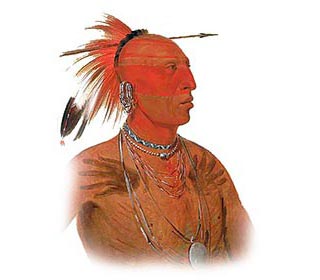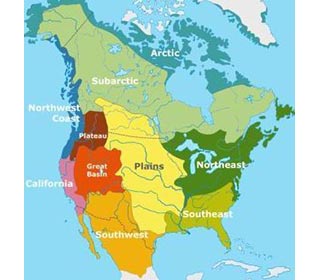Pawnee Villages
The Pawnee built their earth lodges near their fields, usually on bluffs overlooking the River Platte. The biggest Pawnee village was situated on the Loupe Fork of the Platte River and accommodated about 2,500 people. Each earth lodge was capable of holding several families. The village was completely destroyed in 1876, and the Pawnee tribe were removed to the Indian Territory. What language did the Pawnee tribe speak?
The Pawnee tribe spoke in the Caddoan language. The Plains tribes had many different languages and used sign language to communicate. The name Panee or Pani means wolves, and the sign language name for the Pawnee consisted of a representation of the ears of a wolf. The reason they were called wolves is believed to derive from their use of wolf skins as camouflage in order to get near an enemy camp for stealing horses. What did the Pawnee tribe eat?
The food that the Pawnee tribe ate included the crops they raised of corn, sunflower seeds, pumpkins and squash. The food from their crops was supplemented by meat, especially buffalo, that was acquired on their seasonal hunting trips. The meats also included deer, elk, bear and wild turkey. Their main food were supplemented with roots and wild vegetables such as spinach, prairie turnips and potatoes together with berries and fruits such as melon. When food was scarce the Pawnee tribe ate dried buffalo meat, called pemmican. What weapons did the Pawnee use?
The weapons used by the Pawnee tribe included bows and arrows, stone ball clubs, hatchet axes, spears, lance and knives. Painted war shields were used on horseback as a means of defence. What clothes did the Pawnee men wear?
The clothes worn by by the Pawnee men consisted of breechcloths, buckskin tunics and leggings. Warm buffalo robes or cloaks or blankets were also worn to protect against the rain and the cold. They wore moccasins to cover their feet, a soft, light beige, slip-on shoe, consisting of a sole and sides made of one piece of leather. What clothes did the Pawnee men wear? Roach Headdresses
The men of the Pawnee tribe wore Roach headdresses (also called porcupine roaches) that were attached to a scalp-lock and stood straight up from the head like a tuft or crest. The roach headdresses were made of a stiff thin strip of animal hair placed over the top of the head which were held open by comb-like objects, originally carved of antler, called roach-spreaders. Roach headdresses were made from a variety of hairs including white deer tail hair, often dyed red, moose-hair, porcupine hair and black turkey beard. Sometimes feathers, arrows or shells were added as decorations. Some of the Pawnee Chiefs also wore long war bonnets.. Pawnee Clothing
The women of the Pawnee tribe were responsible for making the clothes worn by the people. Most garments were sewn from the soft, tanned skins of deer (buckskin) and buffalo hide. Pawnee clothing was often decorated with paint, porcupine quills or beadwork. Pawnee clothing for both men and women were adorned with ornaments, especially necklaces and earrings. What clothes did the Pawnee women wear?
The type of clothes worn by the Pawnee women were knee-length dresses and leggings. The women also wore the buffalo robes to keep warm and dry. The dresses of the Pawnee women that were used for special ceremonies were intricately decorated with beads and intricate paintings. Dresses were painted with symbols that reflected their tribal identity and family values celebrating acts of courage by their men or sacrifices made for the well-being of the family and tribe. Pawnee women wore their hair long worn in two, thick braids that were often decorated with beads. Pawnee Pictograms
The Pawnee used Pictograms on their clothes and tepees to convey a story through pictures, signs and symbols that signified and resembled the shapes of physical objects or people. The article on the Native Indian use of pictograms includes a picture of a Pawnee robe that depicts a Pawnee battle, their horses, family and symbols for the sun, stars and moon. Who were the most famous leaders and chiefs of the Pawnee tribe?
The most famous leaders and chiefs of the Pawnee tribe included Man Chief, Crooked Hand, Eagle Chief, Brings Herds, Struck with a Tomahawk, Rattlesnake. The Pawnee had many enemies amongst the other Plains Native Indians including the Cheyennes, Arapahos, Delawares, Sioux, Comanches, Apaches, and the Kiowas. Who were the Pawnee?
The Pawnee tribe are believed to have originated in the far south and Mexico. The Pawnee Confederacy consisted of four bands: Chowee or Grand Pawnees Kitkehahki or Republican Pawnees Pitahawirata or Tapage Pawnees Skidi Pawnees (Mahas, or Loups) or the "Wolf" people
Pawnee History: What happened to the Pawnee tribe?
The following history timeline details facts, dates and famous landmarks and battles fought by the Pawnee Nation. The timeline explains exactly what happened to the Pawnee tribe. Pawnee History Timeline 1250: The Pawnee tribe migrate from the Ohio Valley to the Great Plains region 1541: The Spanish explorer Francisco Vasquez de Coronado made first white contact with the tribe 1720: Spanish send military expedition over trade disputes trade and are destroyed by the Pawnee 1746: Major conflict with Comanche and the Osage tribes 1770: Southern Pawnees migrated north near the Northern Pawnee (Skidi) Platte River, Loup River, and the Republican Fork of the Kansas River (Nebraska). The Pawnee continued their farming lifestyle living in fortified villages of earth lodges but extend their lifestyle to include hunting 1790: Comanches defeat the Pawnees after 3 years of conflicts 1816: The practice of human sacrifice is banned 1818: Treaties with the US were signed in June 1818 by all the Pawnee bands 1825: Treaty at Fort Atkinson and the regulation of trade 1833: Treaty at Grand Pawnee Village on October 9, 1833 ceded "all land lying south of the Platte River: annuity: $4,600 in goods" 1833: the Leonid meteor shower fell on November 13, 1833 - the 'Year the stars fell' 1834: The First Dragoon Expedition (also called the Dodge-Leavenworth Expedition or Pawnee expedition) 1837-56: Council Bluffs Agency established 1837: Smallpox epidemic strikes the Pawnee villages 1848: Treaty at Fort Childs, Nebraska ceded 60 mile strip on the Platte River and Grand Island 1849: Cholera and smallpox epidemics led to the extermination of many Pawnees and the destruction of their villages 1859 Judge James Lisle Gillis was appointed special agent for the Pawnees establishing a reservation in Genoa, Nance County, Nebraska 1859-80: Pawnee Agency (Nebraska)
1861-1865: The Pawnee held positions as scouts in the U. S. Army during the Civil War. A battalion of Pawnee being in active service from 1865 to 1885 1873: Massacre Canyon. On August 5, 1873 a Sioux war party ambushed a Pawnee hunting party killing 150 1873: The Pawnee Dispersal (1873 - 1878). The Pawnees removed from homeland along the Platte River in Nebraska to a reservation in Indian Territory near the Cimarron River (Pawnee County, Oklahoma) 1876: Buffalo are wantonly slaughtered all over the Great Plains depriving the Native Indians of their means to live 1876: The largest village on the Loupe Fork of the Platte River was completely destroyed during the Pawnee tribe dispersal
Pawnee History Timeline The Story of Pawnee
For additional facts and information refer to the legend and the Pawnee Story of the Mud Pony. |


